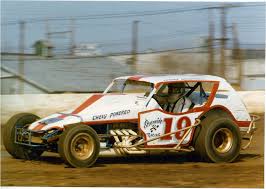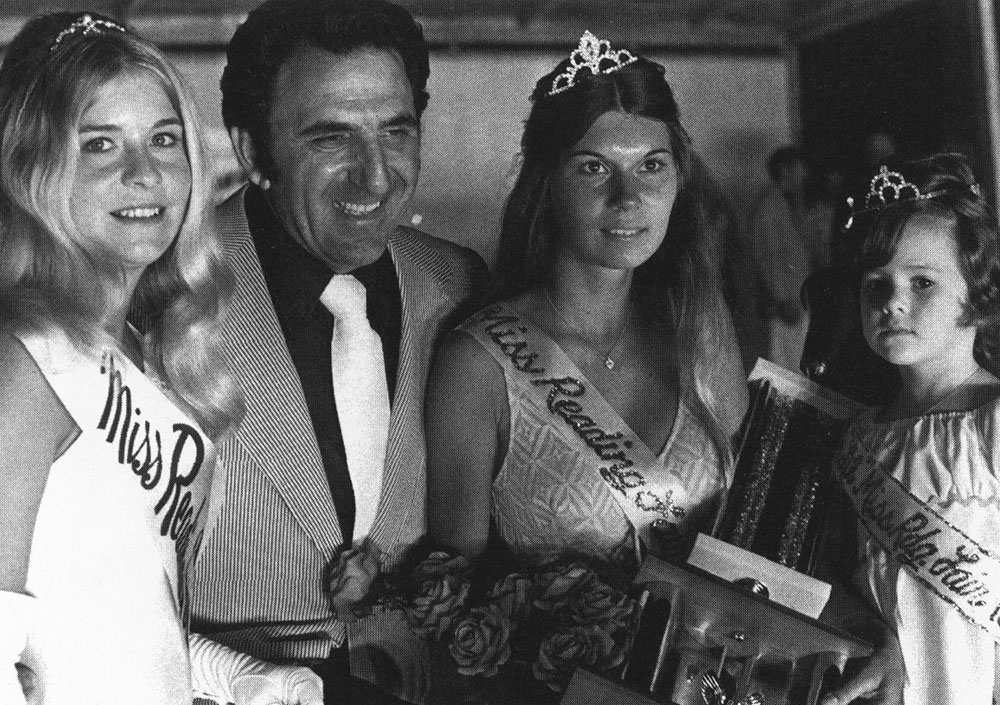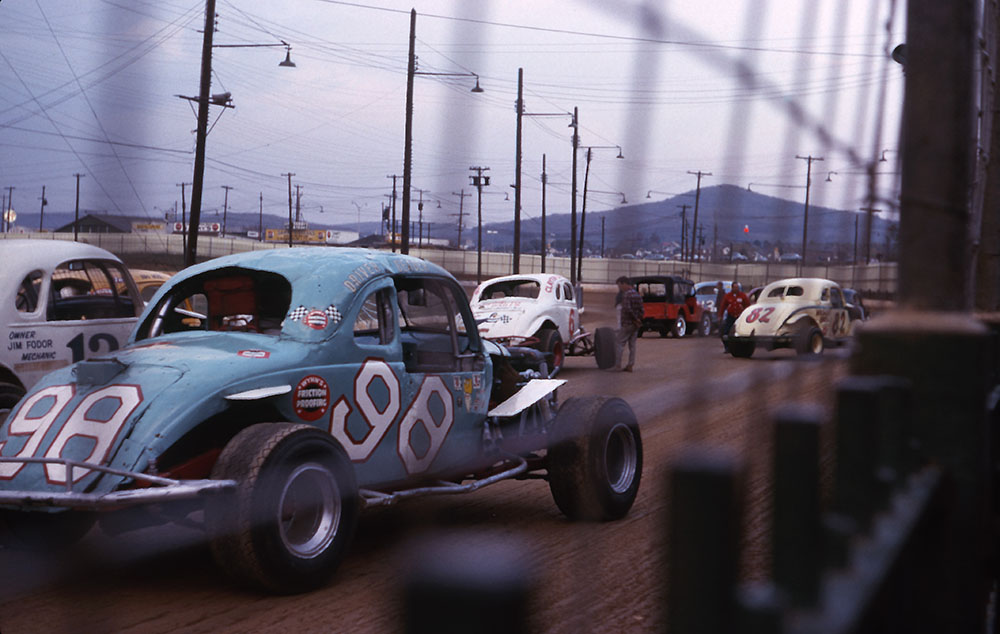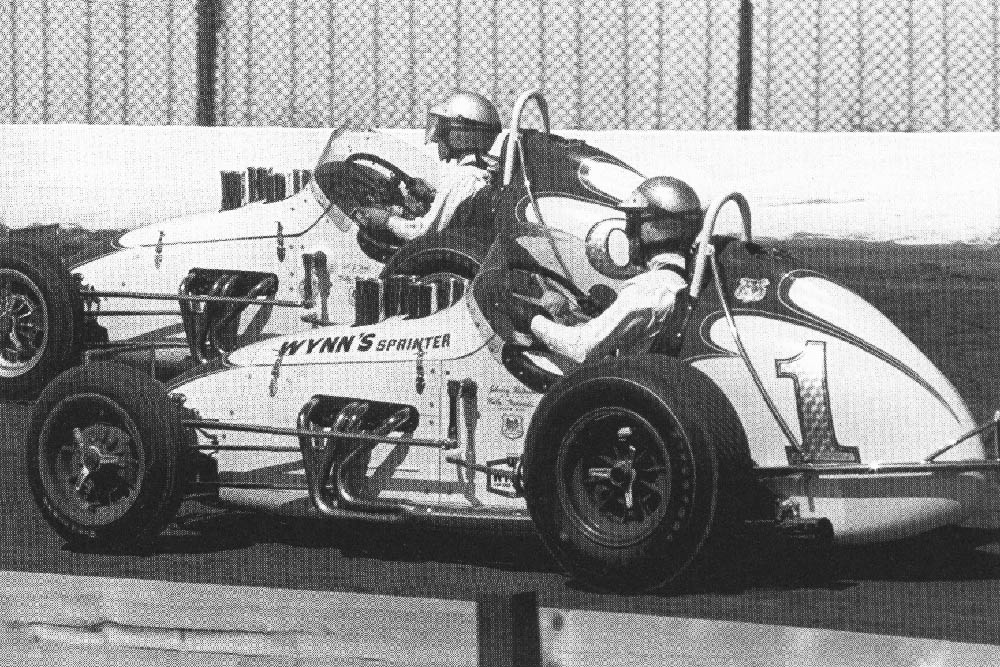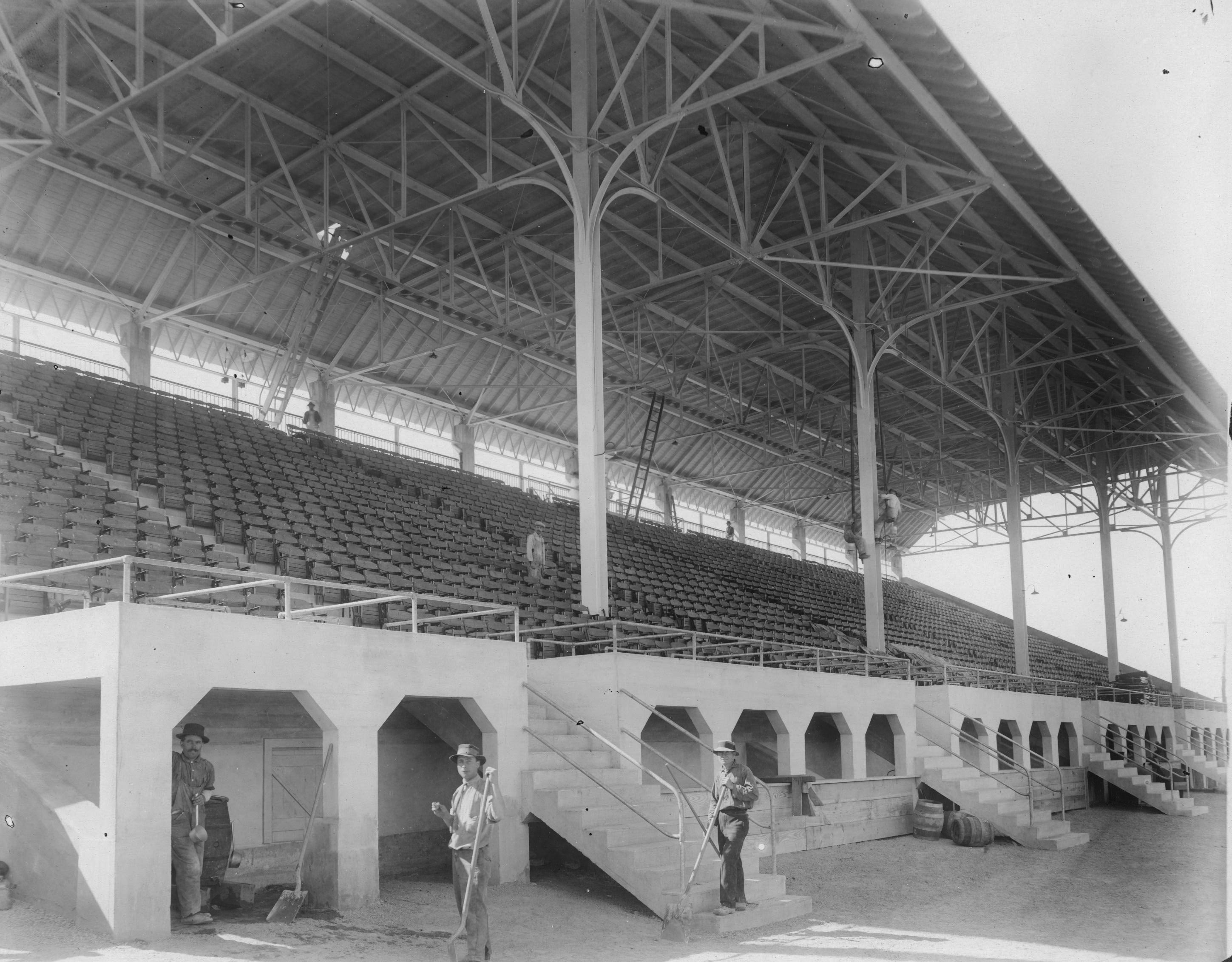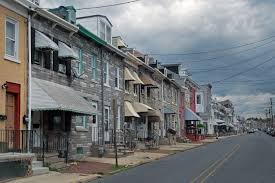
Greetings from Reading, Pennsylvania
From the travels and adventures of the
“World’s #1 Trackchaser”
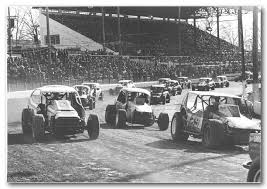
Reading Fairgrounds Speedway
Dirt oval
Lifetime track #46
Reprinted with permission from my Pre-1980 memory!
THE CLASSIC TRACKCHASER REPORT

Editor’s note: This is a CLASSIC Trackchaser Report. What the heck does “Classic” mean? It’s simply a Trackchaser Report that comes from my trackchasing archives. Typically these will be stories from tracks I visited five years or ten years or more ago.
For whatever reason (usually not enough time) this trackchasing adventure didn’t get posted to my website when I first made the track visit. Often a classic TR will not have a video and/or photo album attached. I didn’t begin producing my YouTube videos until 2009 (YouTube channel: RANLAY). I didn’t begin writing a complete Trackchaser Report until I had seen about 425 tracks. This was during the 2000 trackchasing season. Photo albums were sort of hit or miss during the early years of my trackchasing. Additionally, if you see a website link know that link worked when the TR was originally written. Will it work now? Your guess is as good as mine! Nevertheless, this CLASSIC Trackchaser Report has finally bubbled to the surface and is now available for everyone to see at www.randylewis.org. I hope you enjoy it.
I AM A TRACKCHASER.

My name is Randy Lewis (above with Hatem racing federation president – Tunisia). I hail from the sleepy little village by the sea, San Clemente, California. I am a “trackchaser”. I trackchase. Have you ever in your life heard of “trackchasing”? I didn’t think so.
I live in southern California. That’s probably the most inconvenient location in the country for seeing tracks in the U.S. Most of the racetracks in the U.S. are located well over 1,000 miles from where I live. My average trip covers 5,000 miles and more. I take 35-40 of those trips each season. In any given year I will travel well over 200,000 miles, rent more than 50 cars, and stay in more than 150 hotel rooms.
I get the chance to meet people from all over the world. With trackchasing trips to 85 countries and counting just getting the chance to experience so many unique cultures, spend time in the homes of my friends and meet so many people is a huge reward for being in this hobby. I am indebted to several of these folks for their help and friendship.
Once you begin researching my trip itineraries from my website, yes you will want to do that, you will be surprised. One day I’ll be in Tucson, the next in maybe Tuscaloosa and the following day in Syracuse. I do that kind of thing all the time. Figuring out the logistics of a trip like that is as much fun for me as watching a figure 8 race.
Now you know a little bit about my trackchasing addiction. When you receive one of my Trackchaser Reports or find one on my website at www.randylewis.org I hope you will take the time to imagine in your mind what it took to make this trip from SoCal and understand the fun I had doing it.
There you have it. That’s trackchasing…the way I do it. Do others trackchase? Absolutely. Do they share their experiences? Sorry. They don’t. If you want to see the true “essence” of trackchasing you’ve come to the right place.
Today’s adventure was one more of the 2,000 trips that have taken me up, down and around the proverbial long and dusty trackchasing trail. If you would like to see where I’ve been and experience those adventures here’s the link:

If you’ve got a question, comment or whatever please leave it at the bottom of this report. It’s very easy to do. Or you can visit me on Facebook. Thanks!

FOREWORD
Pre-1980.
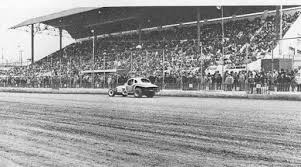
The Reading Fairgrounds Speedway is one of those long ago vintage tracks affectionately known as the “Group of 71”. What’s that you ask?
Prior to 1980 I was a “racechaser”. I had never given much thought to being a “trackchaser”. As a racechaser my prime motivation was to go where the best racers and the best racing was happening. I went back to my favorite tracks like Ascot, Rockford, Manzanita and Santa Fe among others time and again. That’s what a racechaser does.
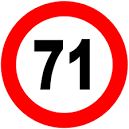
I didn’t give any thought to recording the dates when I visited those 71 tracks. I just went there to have fun and follow my boyhood passion of short track, almost all the time dirt and almost all the time stock car racing. Racechasing was good enough for me.
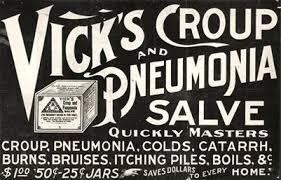
Back in the day, beginning in 1972 I worked for a company called Richardson-Vicks (RVI). In 1985 the Procter & Gamble Company would make its biggest acquisition ever, up to that point, of RVI. I would continue to work for P&G until my retirement in 2002.
RVI had a customer service operation in Ft. Washington, Pennsylvania. From time to time I would visit this office. Whenever I could I would try to time my business visits from all over the country into a racing visit as well. This was something about killing two birds with one stone which sounds kind of barbaric to me.
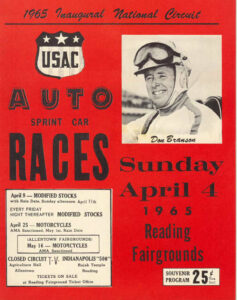
During one of these trips to Ft. Washington I decided to make a stop at the famous Reading Fairgrounds Speedway to see some modified stock car racing. My best guess on the timing would have been 1976-1978.
My memories of that trip are few. I do remember seeing something at the track that I had never seen before. Remember, this was only the 46thdifferent track I had ever seen. Reading had a string of yellow lights that ran overhead from the inside edge of the track to the outside edge of the track. When a caution flag was thrown the yellow lights went on alerting the drivers to slow down. I’m thinking there were a few strings of these lights around the track.
I also remember falling asleep as I watched the racing. This had nothing to do with the quality of the racing! What it DID have to do with was the Eastern time zone!
I was living in California at the time. This was during our first time to live in California from 1975-1979. After that we would relocate to first Connecticut and then Chicago. In 1983 we returned to California where we have resided until this day.
A typical business trip to the customer service center would have me flying into Philadelphia the night before our meeting. When I got to my hotel it was difficult to get to sleep with the three hour time zone change. At midnight in the east it was only 9 p.m. in California (Pacific Time). Of all the things I disliked about business the east coast meetings in the east coast time zones was at the top of the list.
When I finally did get to bed in the east it was commonly 2 or 3 a.m. eastern time, again 11 p.m. or midnight California time. We usually had 7 a.m. eastern time breakfast meetings. I was amazed that the east coast folks scheduling these early meetings had ZERO empathy for their west coast visitors.
In order to get to a 7 a.m. breakfast meeting I would need to get up at 6 a.m. eastern time or 3 a.m. California time. After having gotten a terrible night’s sleep getting up at 3 a.m. “my time” was terrible. That’s why I fell asleep during the racing at Reading! Although I hated eastern time meetings and meetings in general I was tied to the “corporate tit”. There were some sacrifices but there was a reward. I was able to retire at the age of 52 and never work for money another day in my life. Today, as a trackchaser, I commonly get up at some very early hours. I don’t mind to much. I’m calling the shots and that makes all the difference in the world.
So with the knowledge, as limited as it is, that I fell asleep “during the semi” at Reading I will share some research info that I gathered about the famous Reading Fairgrounds Speedway. I know you will find it interesting.
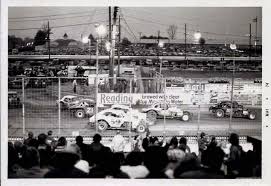
Reading Fairgrounds Speedway, the Home of Champions
Source: www.goreadingberks.com
Wikipedia provided this review of the Reading Fairgrounds Speedway. The track closed in 1979 shortly after my visit.
Reading Fairgrounds Speedway
Reading Fairgrounds Speedway (1924–1979) was a one half mile dirt/clay modified race track located in Muhlenburg Township, Berks County, Pennsylvania. The track opened September 24, 1924 and ran until June 29, 1979.[1] It featured a regular weekly series of modified, sportsman modified, and late model stock car racing. Today where the racetrack once stood is the Fairgrounds Square Mall, which opened in 1980 and closed in 2018.
History
Lindy V. Vicari was a stock-car racing promoter and operator of the Reading Fairgrounds from 1955 until 1979.
All-Time Victory Leaders
Kenny Brightbill is the Reading Fairgrounds Speedway all-time wins record holder with 135 track victories. Tommy Hinnershitz had wins at the track early in his career.
| READING FAIRGROUNDS MODIFIED VICTORIES | |||||
| compiled by Bill Braga | |||||
| DRIVER | TOTAL | 1ST WIN | LAST WIN | ||
| Kenny Brightbill | 135 | 4/17/70 | 6/24/79 | ||
| Gerald Chamberlain | 92 | 7/26/68 | 4/1/79 | ||
| Dick Tobias | 90 | 6/4/65 | 11/20/77 | ||
| Al Tasnady | 52 | 3/31/63 | 6/27/71 | ||
| Bobby Gerhart | 41 | 3/24/68 | 3/25/77 | ||
| Jackie Evans | 20 | 7/30/65 | 5/10/70 | ||
| Freddy Adam | 20 | 6/5/64 | 6/30/78 | ||
| Johnny Botz | 17 | 4/3/71 | 9/7/75 | ||
| Jim Keppley | 17 | 8/8/69 | 10/22/77 | ||
| Kenny Weld | 15 | 3/23/74 | 7/3/77 | ||
| Bobby Blatt | 14 | 7/4/69 | 8/6/71 | ||
| Jimmy Horton | 14 | 6/19/77 | 5/20/79 | ||
| Dave Kelly | 13 | 4/9/77 | 6/29/79 | ||
| Frankie Schneider | 11 | 10/21/62 | 10/17/65 | ||
| Buzzie Reutimann | 11 | 6/28/68 | 10/1/71 | ||
| Jackie McClaughlin | 9 | 5/5/63 | 8/21/64 | ||
| Budd Olsen | 9 | 4/24/64 | 8/19/72 | ||
| Harry Moore | 8 | 7/10/64 | 4/26/74 | ||
| Red Coffin | 7 | 5/29/70 | 5/18/75 | ||
| Meme Desantis | 7 | 8/5/77 | 6/25/78 | ||
| Bobby Hauer | 7 | 5/15/70 | 8/20/78 | ||
| Rags Carter | 6 | 7/9/65 | 7/22/66 | ||
| Stan Ploski | 6 | 9/3/65 | 5/26/68 | ||
| Carl Van Horn | 6 | 8/9/68 | 4/10/71 | ||
| Jim Kirk | 6 | 4/8/72 | 8/21/77 | ||
| John Kozak | 6 | 5/27/77 | 10/8/78 | ||
| Laudan Potts | 5 | 8/8/69 | 9/15/72 | ||
| Bob Malzahn | 4 | 10/22/61 | 5/12/67 | ||
| Hal Browning | 4 | 8/8/71 | 6/30/74 | ||
| Glenn Fitzcharles | 4 | 9/3/71 | 10/25/75 | ||
| Gary Gollub | 4 | 7/10/77 | 7/21/78 | ||
| Billy Deskovick | 3 | 10/6/63 | 10/3/65 | ||
| Tommy McAndrews | 3 | 8/23/63 | 3/12/67 | ||
| Larry Voss | 3 | 8/28/64 | 9/3/67 | ||
| Whip Mulligan | 3 | 7/17/64 | 10/15/67 | ||
| Bill Williams | 3 | 5/9/65 | 9/13/69 | ||
| Billy Osmun | 3 | 9/21/75 | 10/18/75 | ||
| Russ Delp | 2 | 4/19/63 | 4/5/64 | ||
| Shorty Kerschner | 2 | 5/15/64 | 5/6/66 | ||
| Donnie Varner | 2 | 4/6/73 | 4/13/73 | ||
| Don Kreitz | 2 | 10/1/71 | 7/22/75 | ||
| Jim Baker | 2 | 6/16/74 | 9/5/75 | ||
| Walt Olsen | 2 | 4/30/76 | 9/10/76 | ||
| Jay Stong | 2 | 8/26/77 | 10/22/77 | ||
| Mike Meals | 2 | 5/21/78 | 7/9/78 | ||
| Frank Cozze | 2 | 8/7/77 | 7/14/78 | ||
| Tom Hager | 2 | 9/24/78 | 10/22/78 | ||
| Vince Conrad | 1 | 8/30/63 | |||
| Leon Manchester | 1 | 6/19/64 | |||
| Whitey Kerschner | 1 | 6/17/66 | |||
| Bob Siedel | 1 | 9/9/66 | |||
| Will Cagle | 1 | 6/23/67 | |||
| Bob Pickell | 1 | 9/4/67 | |||
| Eddie Pratt | 1 | 3/23/69 | |||
| Ralph Smith | 1 | 4/4/70 | |||
| Dave Marburger | 1 | 4/11/70 | |||
| Dizzie Dean | 1 | 7/5/70 | |||
| Bobby Braxton | 1 | 6/22/75 | |||
| Ronnie Tobias | 1 | 7/14/75 | |||
| Dick Quallio | 1 | 9/3/76 | |||
| Tommy Long | 1 | 4/15/77 | |||
| Freddy Brightbill | 1 | 6/24/77 | |||
| Billy Ellis | 1 | 7/22/77 | |||
| Junior Mikosz | 1 | 7/7/78 | |||
| Ron Tobias | 1 | 9/17/78 | |||
| 65 Drivers | 716 |
Reading Modified Top Ten Performance Index
| DRIVER | 1 | 2 | 3 | 4 | 5 |
| BRIGHTBILL, Kenny | 135 | 80 | 48 | 27 | 13 |
| KEPPLEY, Jim | 17 | 38 | 54 | 39 | 37 |
| TOBIAS, Dick | 90 | 62 | 43 | 36 | 18 |
| CHAMBERLAIN, Gerald | 92 | 52 | 34 | 34 | 21 |
| GERHART, Bobby | 41 | 59 | 46 | 35 | 27 |
| HAUER, Bobby | 7 | 21 | 24 | 30 | 30 |
| ADAM, Freddy | 20 | 18 | 27 | 29 | 23 |
| MOORE, Harry | 8 | 14 | 13 | 27 | 28 |
| KREITZ SR, Don | 2 | 8 | 7 | 11 | 29 |
| COFFIN, Red | 7 | 11 | 17 | 22 | 23 |
| QUALIO, Dick | 1 | 6 | 9 | 3 | 13 |
| REUTIMANN, Buzzie | 11 | 22 | 18 | 26 | 18 |
| BOTZ, Johnny | 17 | 11 | 18 | 26 | 16 |
| TASNADY, Al | 52 | 26 | 14 | 9 | 11 |
| POTTS, Lauden | 5 | 4 | 12 | 18 | 17 |
| BRAXTON, Bobby | 1 | 2 | 9 | 12 | 19 |
| KELLY, Dave | 13 | 10 | 16 | 10 | 21 |
| OLSEN, Budd | 9 | 16 | 14 | 17 | 14 |
| EVANS, Jackie | 20 | 14 | 19 | 11 | 17 |
| DEAN, Dizzy | 1 | 4 | 7 | 7 | 5 |
| KOZAK, Johnny | 6 | 1 | 7 | 5 | 16 |
| HAMILTON, Jackie | 1 | 5 | 5 | 6 | |
| BLATT, Bobby | 14 | 11 | 9 | 10 | 6 |
| BAKER, Jim | 2 | 7 | 10 | 11 | 6 |
| KIRK, Jimmy | 6 | 6 | 14 | 8 | 8 |
| WILLIAMS, Bill | 3 | 9 | 10 | 10 | 13 |
| BROWNING, Hal | 4 | 5 | 13 | 7 | 10 |
| KERSCHNER, Shorty | 2 | 2 | 7 | 6 | 12 |
| ELLIS, Billy | 1 | 1 | 1 | 7 | 11 |
| McANDREW, Tommy | 3 | 6 | 13 | 9 | 9 |
| CARTER, Rags | 6 | 12 | 4 | 5 | 6 |
| DELP, Russ | 2 | 4 | 3 | 9 | 8 |
| FITZCHARLES, Glenn | 4 | 4 | 7 | 7 | 4 |
| OLSEN, Walt | 2 | 5 | 1 | 9 | 6 |
| LONG, Tommy | 1 | 8 | 10 | 5 | 4 |
| MULLIGAN, Whip | 3 | 5 | 10 | 8 | 4 |
| MARBURGER, Dave | 1 | 3 | 1 | 6 | 2 |
| HORTON JR, Jimmy | 14 | 9 | 11 | 8 | 1 |
| DUNSTAN, Ronnie | 2 | 3 | 2 | 9 | |
| VAN HORN, Carl | 6 | 10 | 4 | 3 | 4 |
| MALZAHN, Bobby | 4 | 4 | 4 | 5 | 5 |
| TOBIAS, Ronnie | 1 | 2 | 1 | 7 | 6 |
| BOTTCHER, Bobby | 1 | 1 | 4 | ||
| DERR, Earl | 1 | 2 | 1 | ||
| SCHNEIDER, Frankie | 11 | 10 | 2 | 3 | 2 |
| COZZE, Frank | 2 | 4 | 2 | 8 | 5 |
| DeSANTIS, Meme | 7 | 10 | 7 | 4 | 4 |
| PLOSKI JR, Stan | 6 | 9 | 4 | 4 | 3 |
| SEIDEL, Bob | 1 | 1 | 1 | 1 | 3 |
| WELD, Kenny | 15 | 8 | 5 | 2 | |
| VARNER, Donnie | 2 | 1 | 6 | 5 | 1 |
| VOSS, Larry | 3 | 3 | 7 | 4 | 3 |
| McLAUGHLIN, Jackie | 9 | 6 | 3 | 6 | 3 |
| MANCHESTER, Leon | 1 | 1 | 4 | 5 | |
| TOBIAS, Ron | 1 | 1 | 3 | 3 | 1 |
| TROUT. Kim | 1 | 3 | 3 | ||
| BEAVERS, Sammy | 3 | 4 | 5 | ||
| BRIGHTBILL, Freddy | 1 | 1 | 2 | 2 | |
| GOLLUB, Gary | 4 | 2 | 5 | 4 | 3 |
| PANTUSO, Vince | 1 | ||||
| SMITH, Russ | 1 | 2 | |||
| FELTY, Elvin | 6 | 5 | 1 | 1 | |
| STEIF, Billy | 2 | 3 | 3 | ||
| KERSCHNER, Whitey | 1 | 1 | 3 | 1 | 1 |
| REIFINGER, Hal | 1 | 3 | 3 | ||
| KENNEDY, Beader | 2 | 3 | 1 | ||
| YOUNG, Bruce | 2 | ||||
| KELLY, Joe | 3 | 2 | 1 | ||
| DESKOVICH, Billy | 3 | 1 | 6 | 3 | 2 |
| ROSSELL, Bob | 3 | 1 | 4 | 5 | |
| PICKELL, Bobby | 1 | 2 | 2 | 2 | 1 |
| SMITH, Ralph | 1 | 1 | 2 | 1 | 5 |
| BALOGACH, Paul | 1 | ||||
| GARBER, Harry | 1 | ||||
| GREEN, Butch | 1 | 1 | 2 | 3 | |
| MILLER, Paul | 1 | 3 | |||
| MEALS, Mike | 2 | 4 | 3 | 1 | 3 |
| STONG, Jay | 2 | 1 | 2 | ||
| CAGLE, Will | 1 | 5 | 3 | ||
| SCHOFFSTALL, Dave | 1 | 2 | 2 | ||
| COLLINS, Kevin | 3 | 2 | 5 | ||
| KREITZ JR, Don | 4 | 2 | 4 | ||
| CONRAD, Vince | 1 | 2 | 1 | 3 | |
| MOORE, Mose | 3 | ||||
| REUTIMANN, Wayne | 1 | ||||
| ALLEN, Bobby | 3 | 1 | 4 | 2 | |
| BALOUGH, Gary | 2 | 1 | 1 | 3 | |
| MIKOSZ, Junior | 1 | 2 | 1 | 2 | |
| BROWN, Ralph | 1 | 2 | |||
| CAPIE, Tom | 2 | 1 | |||
| PRATT, Eddie | 1 | 2 | 1 | ||
| RILEY, Don | 1 | 3 | |||
| OSMUN, Dave | 1 | 1 | 1 | ||
| FITZCHARLES, Paul | 2 | ||||
| OSMUN, Billy | 3 | 2 | |||
| HAVENS, Dick | 2 | 2 | |||
| DETWEILER, Ralph | |||||
| SHEETZ, Tommy | 2 | 2 | |||
| TILLMAN, Herbie | 1 | 1 | |||
| HALDEMAN, Ed | |||||
| BURKHART, Barry | 2 | 1 | |||
| SLEIGHT, George | 1 | 1 | |||
| EPPIHIMER, Bob | 1 | 1 | |||
| COVILLE, C D | 2 | 2 | 2 | ||
| PAUCH, Billy | 2 | 2 | 1 | ||
| HAGER, Tom | 2 | 2 | |||
| VON DOHREN, Barry | 1 | 1 | 1 | ||
| LINGLE, Joe | 1 | 1 | 1 | ||
| DeGROOT, Fred | 1 | 1 | |||
| HARWI, Otto | 1 | ||||
| COX, Dan | |||||
| SHAW, Bob | |||||
| SASSAMAN, Dave | |||||
| RAFTER, Bill | 3 | 1 | |||
| COLLIS, Carl | 1 | 1 | |||
| RICHARDS, Harvey | 1 | 1 | |||
| SWEIGART, Bob | 1 | ||||
| HILDRETH, Elton | 1 | ||||
| SLADE, Ron | 1 | ||||
| DECKER, Charlie | |||||
| LESHER, Red | |||||
| MOYER, Gene | |||||
| CAMERON, Alex | |||||
| SWINEHART, Ray | 1 | 1 | 2 | ||
| KELLY, Mike | 1 | 1 | |||
| DICKSON, Larry | 1 | 1 | |||
| SKIAS, Chris | 2 | ||||
| ERB, Mike | 1 | ||||
| TAYLOR, Lee | 1 | ||||
| BUTLER, Gary | 1 | ||||
| GEORGE, Del | |||||
| SCHELL, Tim | |||||
| PAXTON, Lynn | |||||
| TILLEY, Ray | 2 | 1 | |||
| CRONCE, Howie | 1 | 1 | 1 | ||
| SAUDER, Kenny | 1 | 1 | |||
| WISMER SR, Kenny | 1 | ||||
| WOLFORD, Gary | 1 | ||||
| SEROKA, Lenny | 1 | ||||
| PAULSON, Ronnie | 1 | ||||
| KOCH, Paul | 1 | ||||
| WARREN, Smokey | 1 | ||||
| BRACKEY, Bruno | 1 | ||||
| WEAVER, Mark | 1 | ||||
| FORRETTE, Maynard | 1 | ||||
| GEMENDEN, Phil | 1 | ||||
| GRBAC, Mike | |||||
| GILMORE, Charlie | |||||
| OCHS, Larry | |||||
| FRENCH, Ralph | |||||
| SNELLBAKER, Smokey | |||||
| KANTORSKY, Pete | |||||
| ROHS, Steve | 1 | 1 | |||
| BLACKLEY, Johnny | 1 | 1 | |||
| DENGLER, Smokey | 2 | ||||
| BREEDING, Walt | 1 | ||||
| REICHERT, Joe | 1 | ||||
| STUMPF, Don | 1 | ||||
| HULBERT, Mert | 1 | ||||
| GRIFFIN, Pee Wee | 1 | ||||
| WIMBLE, Bill | 1 | ||||
| NOTHSTEIN, Junior | 1 | ||||
| EARNSHAW, Leigh | |||||
| VOLZ, Tony | |||||
| HUBBARD, Johnny | |||||
| LODER, Don | |||||
| SOLOMON, Larry | |||||
| JOHNSON, Alan | 2 | ||||
| SCOTT, Tighe | 1 | ||||
| OSBORNE, Lee | 1 | ||||
| STIVES, Don | 1 | ||||
| FELTY, LeRoy | 1 | ||||
| KNEISEL, Dave | 1 | ||||
| HIEBER, Gary | 1 | ||||
| OPPERMAN, Jan | 1 | ||||
| SPENCER, Ed | 1 | ||||
| SADLER, Blaine | 1 | ||||
| LYNCH, Ed | 1 | ||||
| WILLIAMSON, Kramer | |||||
| BLUM, Bill | |||||
| HENDRICKSON, Lee | |||||
| BUNTING, Harold | |||||
| KATONA, Les | |||||
| HOLLAND, Eddie | |||||
| STECKER, Russ | |||||
| FARLEY, Ed | |||||
| VAN KIRK, Billy | |||||
| BITTING, Del | |||||
| ABEL, Bobby | |||||
| GUEST, Terry | |||||
| ZIMMERMAN, Dick | |||||
| BROMMER, Aaron | |||||
| DALLENBACH, Wally | |||||
| STRUPP, Sonny | |||||
| WINKS, Jimmy | |||||
| HEIN, Jim | |||||
| REAKES, Sammy | |||||
| JOHNSON, Bob | |||||
| MATTA, Tony | |||||
| ELY, George | |||||
| DIFFENDORF, Don | 1 | ||||
| REIDER, Blackie | 1 | ||||
| RUDY, Jack | 1 | ||||
| MAYBERRY, Tom | |||||
| GILLETTE, Don | |||||
| JOHNSON, Jack | |||||
| LAPE, Dave | |||||
| KESSLER, Randy | |||||
| YETTER, Richie | |||||
| REINERT, Noot | |||||
| WELLER, Curt | |||||
| DONAHUE, Joe | |||||
| LAZZARO, Lou | |||||
| EMERICH, Bob | |||||
| DISSINGER, Butch | |||||
| McCAUGHEY, Craig | |||||
| BAILEY, Charlie | |||||
| BRENN JR, Ken | |||||
| CARROLL, Jackie | |||||
| GRIFFIN, Bernie | |||||
| KEMMERER, Jim | |||||
| HARRISON, George | |||||
| ROMER JR, Joe | |||||
| TRAUTMAN, Bob | |||||
| BUSS, Del | |||||
| CHARLES, Harry | |||||
| EPPOLITE, Frank | |||||
| FREYER, Karl | |||||
| HERN, Tom | |||||
| MEAHL, Ken | |||||
| SHIRK, Darryl | |||||
| ROCHELLE, Paul | |||||
| ALLEN, Jerre | |||||
| TROUT, Bob | |||||
| WALES, Milford | |||||
| HALL, Bob | |||||
| TAYLOR, Larry | |||||
| BEHRENT, Harry | |||||
| CLEAVER, Dennis | |||||
| EPRIGHT, Fritz | |||||
| GUINTHER, Ronnie | |||||
| LAWSHE, Art | |||||
| MURPHY, Johnny | |||||
| RADFORD, Paul | |||||
| READINGER, Dan | |||||
| SHARP, Henry | |||||
| SHIRE, Charlie | |||||
| WISMER JR, Kenny | |||||
| COREY, Pete | |||||
| GAHAN, Ernie | |||||
| STANTON, Dave | |||||
| drivers | 1 | 2 | 3 | 4 | 5 |
| SUMMARY | 716 | 714 | 715 | 715 | 715 |
| 1 TIE (1st) – Freddy Adam & Jackie Evans – 8/13/1967 | |||||
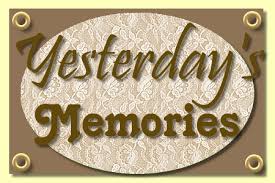
You might have remembrances about this track. If so, please feel free to share your memories in the comments section below. If you have any photos from back in the day, send them to me at Ranlay@yahoo.com. I’ll try to include them here.
Thanks for reading about my trackchasing,
Randy Lewis
World’s #1 Trackchaser
Peoria Old Timers Racing Club (P.O.R.C.) Hall of Fame Member
That’s all folks! Official end of the RLR – Randy Lewis Racing Trackchaser Report
Click on the link below to see the video production from the racing action today.
Thanks to Concepts II Video Productions…they did a great job with this.

